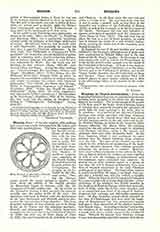

Window, Rose.—A circular window, with mullions and traceries generally radiating from the center, and filled with stained glasses. The term is suggested by the fancied resemblance of the window with its traceries to the rose and its petals. The rose window is one of the most beautiful and characteristic features of medieval architecture, especially of the French Gothic, in which it achieved its most perfect development. Its origin is to be found in the Roman oculus. During the Romanesque period the oculus became a window, and from about the middle of the twelfth century its dimensions began to increase with the development of Gothic architecture. By the middle of the thirteenth century it had attained the greatest possible size—the entire width of the nave. Its splendor continued in France until the misfortunes of the later fourteenth and fifteenth centuries prevented the construction of large churches. The most beautiful examples of rose windows are to be found in the Ile de France and the adjoining provinces, Picardy and Champagne. The earliest important examples are the west rose of the Cathedral of Mantes(c. 1200); the west rose of Notre Dame of Paris(c. 1220), the most beautiful of all, and those of Laon and Chartres. In all these cases the rose was put under a circular arch. The next important step was to put it under a pointed arch, as was done in the beautiful rose windows of the Cathedral of Reims, (1230), as well in the transepts as in the later roses of the facade. Thereupon the rose was inscribed in square, with pierced spandrils as in the transepts of Notre Dame of Paris (1257). The last step was to place the rose in a tier of lower windows, in which case it became the center of a vast window composition, covering the whole end of the transepts, as in Rouen Cathedral.
In England the use of the rose window was usually confined to the transepts, although roses of great span were constructed in Byland Abbey and in the east front of Old St. Paul’s, London. In Germany it was more frequently used as well in the Romanesque as in the Gothic period; a fine example is in the facade of the Cathedral of Strassburg. In Italy it was particularly used by the Lombard architects, as in San Zeno, Verona, and in the Cathedral of Modena, and in the Tuscan Gothic churches like the Cathedrals of Siena and Orvieto. These roses were always filled with stained glasses of great beauty, adding not a little to the picturesque effect of the interior of the cathedral.
G. KRIEHN

